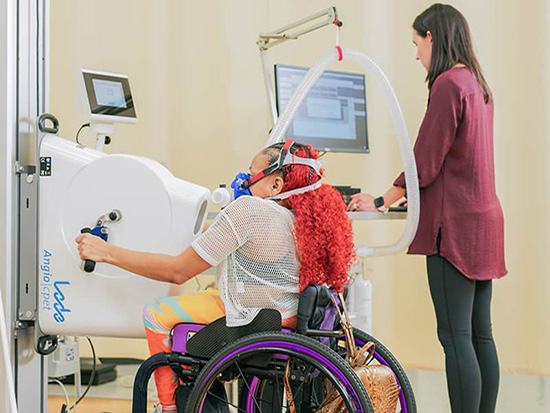 Since its designation as a University-Wide Interdisciplinary Research Center (UWIRC) in 2019, the Center for Engagement in Disability Health and Rehabilitation Sciences (CEDHARS) has cultivated a strong partnership with the Department of Physical Medicine and Rehabilitation (PM&R) to broaden research and advance aligning mission and vision.
Since its designation as a University-Wide Interdisciplinary Research Center (UWIRC) in 2019, the Center for Engagement in Disability Health and Rehabilitation Sciences (CEDHARS) has cultivated a strong partnership with the Department of Physical Medicine and Rehabilitation (PM&R) to broaden research and advance aligning mission and vision.
“PM&R serves many people with disabilities who benefit, either directly or indirectly, from the research funded and serviced through CEDHARS,” said Dr. Jereme Wilroy, associate professor in PM&R and director of research at the Lakeshore Foundation. “I believe it has been a great partnership, and it has certainly benefited my lab.”
The ultimate goal of CEDHARS is to bring together researchers from all disciplines to make their work adapted for, or inclusive of, people with disabilities for what CEDHARS Director Dr. Jim Rimmer termed inclusion science.
CEDHARS annually offers pilot funding for researchers looking to launch their research and prepare for larger grant funding from federal agencies. Pilot RFAs have included general inclusion science and secondary-data analysis, some of which were conducted on the PM&R’s SCI and TBI Model Systems.
“The CEDHARS pilot program has provided an excellent opportunity for young researchers in my lab,” Wilroy said.
CEDHARS also offers a multitude of core facilities that many PM&R researchers utilize from virtual reality active gaming to rehabilitation engineering and health promotion.
The Adapted Human Performance Lab (AHPL), located at CEDHARS homebase in the Wellness, Health and Rehabilitation Facility (WHARF) on Lakeshore’s campus, offers a plethora of exercise equipment adapted for people with disabilities. AHPL also houses a staffed wet lab for blood draws, which is appealing to faculty because researchers often have difficulty scheduling blood draws in hospitals for gathering biomarker data in their studies.
“CEDHARS has provided services to support both my Neilsen Foundation pilot project and my NIH R01,” Wilroy said. “The Adapted Human Performance Lab has been instrumental in key assessments for the R01 project, such as blood draws for evaluating our primary outcome.”
Dr. Rachel Cowan, associate professor in PM&R, houses her adapted equipment, the Lode Esseda, in AHPL. The Lode Esseda is a wheelchair resistant treadmill that measures power and exertion for wheelchair users, and is one of only 15 in the world.
The innovative nature of the equipment brought Rowie Janssen, Ph.D. candidate in human performance science, from the University of Groningen in the Netherlands to collaborate with Cowan on her own research.
“The research is really closely aligned with my own research, and my supervisor has a close connection with Dr. Cowan,” Janssen said. “I got to meet and work with the CEDHARS lab manager, which was a really positive experience.”
Traditionally, hand crank chairs have been used by researchers, but Janssen said the Lode Esseda is on the forefront of science because of its applicability for wheelchair users.
“If you are a runner, you do maximal exercise or efficiency testing on a treadmill because that’s how you run, and if you’re a cyclist, you’re doing your performance testing on a bike, so if you are a wheelchair athlete or user, you do all your daily activities in a wheelchair, and it makes much more sense to do your testing that way,” Janssen said.
Janssen hopes this equipment can be used by high-performance Paralympic athletes as participants get applicable data for the first time in a wheelchair. But, as is the case with all services in AHPL, the Lode Esseda is also used to measure the effectiveness of exercise interventions for daily life.
“At the Adapted Human Performance Lab, people were really open, really friendly and wanted to help me get the most out of it,” Janssen said.
Article written in collaboration with Stephen Lanzi and CEDHARS.